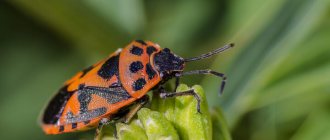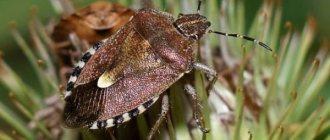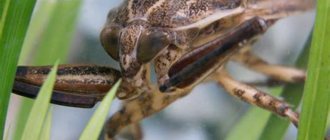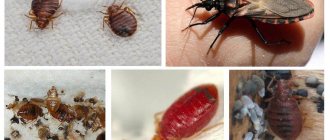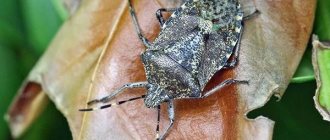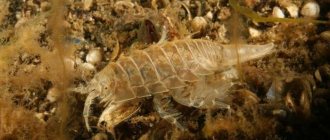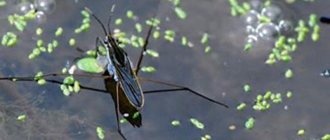Bug bug: development phases and where it lives
These insects pose a danger to various plantings. They cause the greatest harm to grain crops (favorite foods: rye, barley, wheat). To remove harmful bugs from plants, you need to inspect the area, the more often the better. The bug can fly, which allows it to move long distances. This is how remote fields are infected.
But parasites are also found in gardens and gardens.
The bug causes the greatest damage to grain crops.
Here they prefer to destroy tomatoes. When it starts to get colder, pests can get into human housing, as they rush to the heat source.
The tortoiseshell is not a fully metamorphosed insect.
Bedbugs of this species go through several stages of development and skip pupation:
- eggs - the duration of maturation varies from 1 to 3 weeks, which depends on living conditions;
- larvae - develop over 1-2 months, the period of formation of their body also depends on air temperature and other parameters; insects need to go through several stages of molting before sexual maturity;
- imago – sexually mature pests, capable of reproducing.
Most often, insects of this species are found in the steppe zone. They are also found in large numbers in the southern forest-steppe of Ukraine, as well as in Russia, Asia, Bulgaria, North Africa, Albania, and Greece.
What does a pest bug look like? Close-up photo of adults and their larvae
It is very difficult to detect clutches of turtle bug eggs.
Turtles can completely destroy a crop.
You should look for beetles on plants (in fact, they belong to the family of shield turtles) with external signs:
- body length 10-13 mm;
- the outer covers are light brown, but there are also individuals with a darker color - even black;
- 3 pairs of limbs;
- the edges of the pronotum are convex, rounded;
- if you look at the pest from above, you won’t be able to see the limbs; from this angle, the insect resembles a turtle, which determined its name.
Description of the insect
The harmful turtle is so called because of its characteristic appearance. They called her harmful because she leads a parasitic existence. This insect cannot be called a predator, but still it happily feeds on cultivated cereal plants and is their main pest. Those who suffer most from it are:
- Wheat.
- Barley.
- Oats.
There is no other creature in nature that could cause such harm to these types of plants. This insect especially loves to feast on wheat.
Habitat region
This insect is heat-loving, so it lives in regions with high average annual temperatures. It occurs most often:
- In northern Africa.
- He also feels comfortable in the Balkans.
- In Western and Central Asia.
- And also in Russia, this could be the Central region, the Volga basin, the North Caucasus, the Chelyabinsk region, the Krasnodar region, Bashkortostan.
Appearance and method of reproduction
An adult insect can be from 10 to 13 cm in length, it is colored brown-gray and has a very dense carapace. It has whitish patterns on its back. The insect flies beautifully on its rounded wings and, if necessary, can travel up to 200 km in search of food. The insect lands on a plant, bites its stems and sucks out the juice.
Its lifespan is short, only about one month. During this time, the female manages to lay eggs, and their number is always a multiple of seven. She puts them on the underside of the leaf, in so-called bags, seven in a row. After 6–28 days, young individuals called nymphs will hatch from the eggs.
Stages of development
The hatched turtle bug larva goes through five developmental periods:
- At the first stage of development, the larva reaches sizes from 1.5 mm in length to 1.3 mm in width. At this time it has a rounded convex shape. Its color changes from light pink at the beginning of this period to dark brown at the end.
- At the second stage, the length of the larva reaches from 2 mm to 2.3 mm, and the width - 1.6 mm. At this time, the shape becomes oval and the color brightens significantly. It becomes yellowish-gray in color.
- At the third stage, the length of the harmful turtle larva becomes from 3.3 to 4.5 mm, width - from 2.4 to 2.7 mm. The larvae take on an ovoid shape.
- At the fifth stage, its length is 5.2-6.1 mm, width 3.8-4.5 mm. It is colored light yellow, and the rudiments of the front wings are visible on its body.
- At the last stage, the larva reaches a length of up to 10 mm and a width of up to 6.7 mm. It is painted brown-gray.
During the winter, the insect hides under fallen leaves and spends the entire cold season there. When the frosts recede and the air temperature reaches 15 degrees, the bug begins its active life. Waking up from hibernation, the insect flies to the nearest cereal plants, preferably wheat. Mating of the harmful turtle also occurs during this period. The female can lay up to 150 eggs at a time.
What can affect the increase in the number of bugs in wheat:
- if there are a large number of weeds in the cereal field;
- if the crops were harvested untimely;
- favorable wintering conditions for the turtle bug and the presence of warm spring weather.
Features lifestyle
The lifespan of insects is 10-12 months. This is an average figure, because pests of this species are greatly influenced by environmental conditions. Insects spend most of their lives in fields, feed here, and reproduce.
Only adults are able to survive winter.
They look for places to hide under old leaves in the forest and shelter belt, as well as next to a person - in a personal plot in the garden.
After harvesting, you need to burn all garbage and leaves to prevent the spread of bedbugs.
Reproduction of harmful turtle
Insects wake up when warming reaches +12°…+15°С. This allows them to begin searching for new habitats where they can gain unlimited access to food. Approximately 1-2 weeks after this, the insects begin a period of active mating. The female needs food to lay eggs. During her life she can lay 45-225 eggs. The maximum number of clutches is 15, each with up to 15 eggs. But still, the average is 3 clutches per season.
The offspring of the turtle bug cause a lot of harm
Signs of a harmful turtle
Bedbugs lay eggs on young shoots of grain or garden crops, weeds, and even dried parts of plants. The larvae destroy shoots, and the adults mainly destroy grain. Signs that suggest plant infection:
- underdevelopment of shoots, their damage, change in shape, appearance of traces of damage;
- inhibition of growth of the entire plant;
- decrease in yield;
- white-haired grains;
- mechanical damage to grain, a change in its properties, which leads to a deterioration in the quality of flour obtained from it.
Anastasia, 34 years old, Krasnoyarsk
A bug like this appeared in my dacha. Literally destroyed the entire tomato crop. And those vegetables that he did not have time to damage were spoiled by the smell.
Oleg, 39 years old, Rostov-on-Don
It is difficult to find pests with the naked eye, because their color is inconspicuous. Moreover, bugs can hide under the foliage, from the bottom of the fruit. I missed their invasion so much. It turns out that they move quickly through the air, so it is impossible to stop the infection of the area.
Habitats and features of existence
Grains are the main food source for turtle bugs. Numerous colonies of these insects can cause enormous damage to land and destroy fairly large crops.
Parasites overwinter in the forest, where fallen leaves or perennial weeds serve as temporary shelter for them. If they find a warehouse with wheat nearby, they will certainly move there. In such barns it is very comfortable for them to spend the winter - cozy and satisfying.
With the onset of spring, when the air temperature rises to +15°C, hordes of bedbugs fly in search of food. Most often they stop in fields where early winter crops have already sprouted. Such places are ideal for living and mating.
Females lay eggs directly on plant stems within two weeks after mating. After 7 days, young growth appears from them, which immediately begins to suck the juice from the young shoots.
Attention! The number of bedbugs grows very quickly, and they can completely destroy the crop in the area where they have settled.
As mentioned above, the larvae go through five stages of maturation and the entire period lasts about a month. At each stage, the bug molts and gradually acquires the characteristic color and body shape of an adult insect. At each new stage, the parasite increases in size and therefore there is less and less space on the stem. In this way, they spread to neighboring spikelets and after a short period of time they fill the entire field.
How harmful an insect is and how to detect it
Bedbugs of this species inject a special enzyme into plant tissues and grains. It promotes structure changes. In this case, gluten loses its properties, and the grain becomes unsuitable for flour production. At the same time, the finished product not only loses useful substances, but also has a different taste; it cannot be used to make baked goods. As a result, the flour does not comply with GOST.
Close-up photo: grain damaged by a bug
Bedbugs do not leave bites on plants, but punctures. Damaged areas are invisible. But gradually a dark spot appears. It is framed by a light yellow spot. The grain tissues wrinkle in this area. If you press, the endosperm will crumble. Fabrics lose elasticity, grain is no longer dense and elastic.
Similar signs appear on tomatoes.
The turtle bug introduces an enzyme into the plant tissue that changes the structure of the grains
Photo of a bug on tomatoes
Bug bug on tomatoes
Photo of a bug on a raspberry
Bug pest on raspberries
What does it eat?
The harmful bug is fixed at the base of the stem, because active growth processes take place there, the leaf structure is loose and juicy. Then it moves higher as the bud rises upward.
The insect makes a puncture in the plant with its sharp proboscis, introduces digestive enzymes that corrode the inside of the stem and cause it to rot. The bug sucks out the decomposed tissues of the plant, and it can no longer bear fruit, since the flow from the root to the ovary is disrupted.
Particular harm is caused to the following crops:
- wheat;
- millet;
- corn;
- oats;
- raspberries;
- tomatoes;
- sweet pepper.
The turtle bug damages wheat.
Natural reduction in the number of turtle bugs
In this case, negative external factors are considered. If turtles are regularly exposed to them, the size of the colony decreases. But most often, it is not individual factors that influence, but a whole complex of environmental parameters. These include:
- temperature: if the value rises to +30°C, the clutch of eggs may dry out;
- 1st instar larvae die en masse, because they are more susceptible to the influence of negative factors, for example, bedbugs at this stage can be washed away by heavy rains, since in open flat areas (in fields) the probability of flooding is high;
- death of oviposition occurs under the influence of mechanical loads;
- The average temperature in the area during the flight of overwintered insects also plays a role;
- death of individuals at any stage of development occurs due to late frosts in early spring.
The smell after a turtle bug is very strong and difficult to get rid of.
If the temperature is low in the spring, the weather is humid and cool, the period of development of the turtle bug increases.
This leads to a decrease in the number of such pests, since fewer eggs appear, and accordingly, the number of individuals that can produce offspring upon reaching sexual maturity decreases.
Fighting the turtle bug
Destruction of insects is a complex process, because it is impossible to predict where they left their eggs. Even if most of the area is treated, pests can still survive if one of the clutches remains untouched. When the bug bug is expected to appear on tomatoes, control measures should be of different types.
Aktara drug against bugs turtles
Chemicals against pests
To kill insects in areas where grain or garden crops are grown, as well as in fields, special types of preparations are used. They simultaneously combine different properties: they provide efficiency and cause less harm to plantings.
| Drug name | Peculiarities | price, rub. |
| Aktara | Insecticide of enteric contact action, contains thiamethoxam. The drug is produced in Switzerland. The principle of action is based on the ability of the substance to penetrate plant tissue, from where it enters the insect’s body along with food. | 150 |
| Ephoria | The drug is available in large volume containers. Shows contact and systemic activity and can destroy pests of grain and garden crops. High efficiency is due to the use of two different types of insecticides: lambda-cyhalothrin and thiamethoxam | 5689 |
| Karate Zeon | The drug has a universal effect. Contains lambda-cyhalothrin. This is an insecticide with enteric contact action. The drug is available in the form of a microencapsulated emulsion | 2500 |
| Chlorophos | The advantage of the drug is its prolonged action (for 3 weeks). It contains a substance that is a derivative of phosphonic acid | 1055 |
| Karbofos | The drug is highly toxic - it contains 50% malathion, it is a universal remedy. Residual effect is 1-2 weeks | 5000 |
Traditional methods
If ways to deal with bugs on tomatoes are being considered, the degree of infestation of the plantings should also be taken into account. So, if there are a lot of insects, chemical agents are used. Traditional methods are used if the influence of insecticides that penetrate the tissue structure cannot be prevented, for example, when vegetables are grown for children with allergies.
But most often this method of control is used for prevention or to destroy a small number of individuals at the initial stage of infection.
Herbs
You can plant black cohosh or black cohosh grass on the site (preferably around the perimeter). This is a safe method that does not require complex manipulations. The grass emits a specific odor that is unpleasant to the harmful turtle. You can also prepare infusions based on garlic. You will need 2 heads, 10 liters of water.
The product must be infused for 3-4 days.
Planting an area with black cohosh will reduce the likelihood of pests spreading.
Freezing
Insects withstand long winters in poorly insulated shelters. They can withstand exposure to low temperatures. However, it is almost impossible to influence pests in this way in an open space. It remains to be expected that the winter will be frosty and the individuals will not survive it.
Turtles die when the air temperature drops to -10°C.
Kettle
Theoretically, you can get rid of bedbugs using boiling water. If you pour hot water over the pests, the temperature of which reaches +100°C, rapid death will occur. However, in poor conditions, pests live on plants separately. Looking for them to pour boiling water over is problematic and will take a lot of time. In addition, mature plants may suffer when using this method.
Chemical treatment of turtles should be carried out before the ovary begins.
Vacuum cleaner
You need to not only find out what the turtle bug looks like, which damages tomatoes and other fruits, but also be able to recognize it, because you will have to act quickly.
It is difficult to collect insects with a vacuum cleaner.
In most cases, the length of the cord does not allow the entire area to be cleaned. In addition, bedbugs that are stuck inside the mechanism of the device will emit an unpleasant odor. In the future, using such a vacuum cleaner will be problematic.
Mechanical collection by hand
This method has the significant advantage that no preparation is required and no chemicals are required. It is enough to take a bucket of water or a small container filled with liquid, after which you need to walk around the entire area. But there is also a significant drawback - pests secrete a substance, a special secret, when they are in danger.
The smell is very strong and unpleasant and difficult to remove.
During her life, one female turtle can lay up to 250 eggs
Rules for processing tomatoes
When considering control measures based on the use of chemicals, the need to protect plantings must be remembered:
- treatment of plants is carried out before flowering and formation of fruit ovaries;
- The last insecticide spraying procedure is carried out 3-4 weeks before harvest, which will allow the toxic substances to break down.
Natural enemies of bugs and turtles
Additionally, other pests contribute to the decline in colony numbers. The turtle bug should be wary of:
- hedgehogs;
- centipedes;
- telenomus;
- ant;
- predatory mites.
Moreover, natural enemies can destroy individuals at different stages (imago, larvae) and even eggs.
Hedgehog fly is a natural enemy of turtle bugs
Effective drugs
Insect control
How to treat wheat fields is an individual choice. There are many combination products available on the market.
- Aktara. A highly effective drug with an immediate effect. Treatment is carried out by spraying. Within an hour, the harmful turtle stops feeding and dies within 24 hours. The active components of Aktara provoke muscle paralysis and inevitable death of the harmful insect. It remains valid for about 30 days. Effectiveness is not affected by weather conditions unless it rains within 2 hours of spraying.
- Karate Zeon. A professional product to combat harmful insects. Available in the form of a concentrated emulsion. Before use, it must be diluted in cool water. It acts similarly to the first drug. Damage can be healed within a few days.
You can achieve quick, long-term results using combined methods. The use of poison in early spring significantly increases the chances of victory; by the time of harvest, the toxins are destroyed. The grain does not lose its taste and beneficial qualities. The owners of the fields reap a rich harvest.
It is necessary to periodically inspect fields with grain crops. Take emergency measures immediately after detecting a pest.
Prevention of bedbugs
It is necessary to create conditions under which pests will not appear on the plot. To do this, consider methods that are easy to implement yourself:
- in the spring they plant black cohosh, a grass that releases substances that repel pests;
- in the area where this is permissible, chickens are walked, because they feed on bugs - harmful turtles;
- after harvesting the last harvest, you need to clean the area: collect leaves, dried plants, and burn all the mousse;
- you need to fight weeds in a timely manner;
- The harvest is harvested when the time has come; this moment should not be delayed;
- properly fertilize the soil, add compounds containing phosphorus and calcium;
- they use traditional methods: they treat with herbal infusions and other home remedies;
- They collect pests with their own hands, first putting on gloves.
Collecting bedbugs should be done with gloves
Reviews from gardeners
Evgenia, 38 years old, Saratov
I treated the area near the house with onion peels, but there were still a lot of bedbugs that year. Apparently they migrated in large numbers, looked for food and found it. Then I simply treated the area with Aktara, but we ate the tomatoes very carefully after that.
Anna, 34 years old, Moscow
At the dacha I began to find rounded bugs. They are somewhat similar to green bugs that feed on raspberries, but their backs are more curved. The plants began to spoil, I scared them away with garlic infusion. The smell was strong, but the result was excellent.
Olga, 45 years old, Kazan
The bugs almost destroyed the grain. They saved him with the drug Aktara, but it’s important to catch it in time. We treated in the spring, when the larvae had not yet spoiled all the shoots.
Victor, 39 years old, Novomoskovsk
I had to throw away part of the harvest, but I didn’t give up and saved more than half. I fought in different ways: I collected bedbugs by hand, checked the plant bushes every day, and treated the area with Karbofos twice.
Marina, 28 years old, Tula
Bedbugs of this type develop quickly; at first I found small insects of a light color. Apparently the cycle of their transformation was ending, because after just 1 week the garden was filled with large brown bugs. I started collecting with my hands, but it took a very long time, so I bought Zeon. It immediately became clean.
The adult feeds on grains, and the larvae destroy the shoots
Advice from expert agronomists
Varshavin Boris Viktorovich, 49 years old, Saratov
“In the spring, you need to dig up the area, because egg clutches remain in the surface layer under the vegetation. The soil can be poured with boiling water. If this does not help, you should treat the area with the drug 1 week after warming.”
Korablev Alexey Olegovich, 55 years old, Kazan
“If there are no visible traces of insects yet, you need to frequently treat the area with a decoction of onion peels. This is a universal remedy that helps remove various pests.”
Voronin Rostislav Igorevich, 39 years old, Orel
“To prevent bedbugs from finding your area attractive for habitation, you need to remove old leaves and dry grass, as well as weeds, not only on your territory, but also on adjacent ones. The situation is complicated by the presence of neighbors who do not carefully monitor their plots.”
The garden needs to be cleaned after harvesting to prevent the spread of bedbugs.

